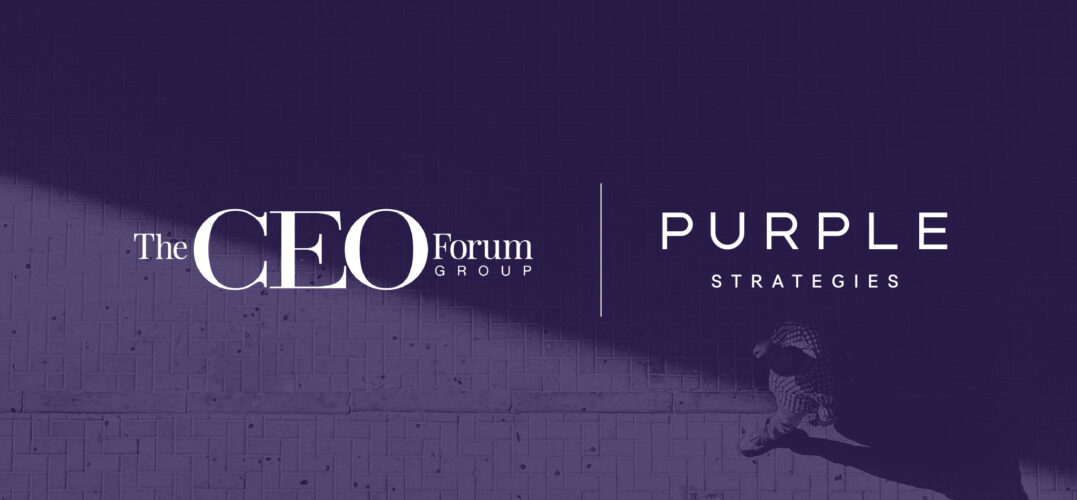Four Aspects of the Chief Executive Role Gaining Visibility
Purple Strategies is the thought leadership partner of The CEO Forum Group and Transformative CEO Summit series, featuring CEOs of leading companies discussing creative ways to solve today’s most pressing challenges.
The role of CEO has evolved beyond leader and decision maker in the corner office to take on a more public persona that embodies how the company wants to show up in the marketplace and with employees. The shift from a more company-centric, internal focus to leading in the spotlight was a prevailing theme shared among CEOs at the latest Transformative CEO Summit in June.
CEO attendees shared four parts of their jobs that are attracting more exposure, and how they’re continuing to build and lead successful companies when all eyes are on them.
(1) The Human Behind the Title
CEOs describe the expectations they’re feeling from employees, investors and others to be more authentic, approachable and vulnerable while running their companies.
In her keynote remarks, Esi Seng, CEO of Tate’s Bakery, said her goal was to inspire a community of CEOs to leverage “the power of real.” As she described it, “That means admitting your mistakes, not knowing all the answers, making dad jokes, and letting people see your flaws.” Employees will reciprocate this behavior, she added, and the exercise will help the business by resulting “in meaningful discussions and questions that provoke change and elevate the thinking.”
Finding the right balance of leadership and accessibility can be a challenge, but CEOs who master the art of authenticity while leading their companies can earn tremendous trust and confidence in the process.
(2) The Business Roadmap

With the rise of employee activism, CEOs are required to be more transparent and proactive with their workforces than ever.
Lynn Tilton, CEO of MD Helicopters, described her views on leadership, “Your greatest responsibility is to take people on that journey with you, to lead from the front.” She highlighted why it is so critical for CEOs to communicate about where the company is and where it’s going, adding, “It is not about what you accomplish yourself. But how many lives are better because you did what you did.”
In a period of heightened interest in what companies are doing and where they are going, CEOs are turning toward transparency and openness to keep employees engaged in the company’s journey.
(3) The Mechanics of Creating Culture

With five generations now in the workforce, CEOs describe the need to more actively and intentionally build an inclusive culture. The things that historically drove in-office company culture – serendipitous moments and impromptu conversations – are less prevalent with remote work and distributed workforces. To strengthen culture now, CEOs have to be even more deliberate.
Giordano Albertazzi, CEO of Vertiv said of his experience, “It’s about being extremely intentional in driving the right culture or the desired culture given where the organization is… This is to the extent that I couldn’t fathom before I was in this current role, but you have to be relentless and very structured to make sure that that culture seeps through the organization.”
Culture is perhaps even more critical in a distributed and hybrid workforce, and the efforts CEOs are making to create strong ones are now more tangible and on display.
(4) The Leader’s POV on Emerging Technologies
Charged with steering their companies to a stronger future, CEOs have long needed to stay apprised of emerging technologies. However, what has changed is the expectations for them to communicate with key audiences about those technologies and their potential impacts. At this Transformative CEO Summit, the topic of artificial intelligence (AI) surfaced across discussion groups, with moderators and attendees seeking the CEOs’ perspectives on how they are thinking about the new technology and forecasting what it could mean for their industries.
While some cautioned against AI’s misuse, many CEOs described the promise they see from this emerging technology.
Adam von Gootkin, CEO of Highclere Castle Spirits, said, “By embracing AI, we can use the tool more effectively to tell our story and give people an immersive experience.”
Separately, Adam Goldstein, Executive Chairman of DLT Global, also added his support, “AI-related tools contain the opportunity to express who you are as a brand much better to customers and potential customers than anything that has existed up until now.”
CEOs are no strangers to identifying and evaluating new technologies. But this Summit suggests that they are being asked to do so sooner and even more publicly.

As the CEO role continues to evolve, what used to be unseen parts of their job are becoming more visible. Important audiences are expecting more insight from executives into their company strategy, culture, future-proofing of the organization, and even their own very humanness and flaws. To build trust and meaningful relationships with these stakeholders, CEOs are learning to embrace the spotlight and guide their businesses to success with even more openness and transparency.
To learn about other dynamics impacting the reputation landscape facing top executives, visit Futurecasting by Purple Strategies.
Explore more from Purple Strategies in the Transformative CEO Summit series:

 Waiting to Engage in D.C. Is the Most Expensive Mistake You’...
Waiting to Engage in D.C. Is the Most Expensive Mistake You’...  The Era of High-Stakes Uncertainty
The Era of High-Stakes Uncertainty  What Forces are Shaping the Future for CMOs?
What Forces are Shaping the Future for CMOs?  Policy Priorities vs. Business Realities: What Executives Ne...
Policy Priorities vs. Business Realities: What Executives Ne...